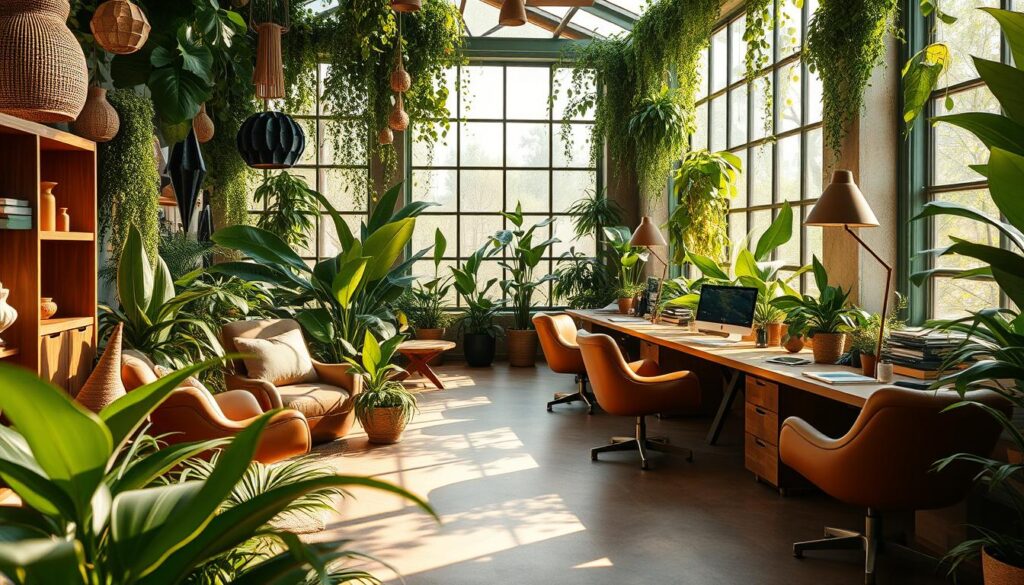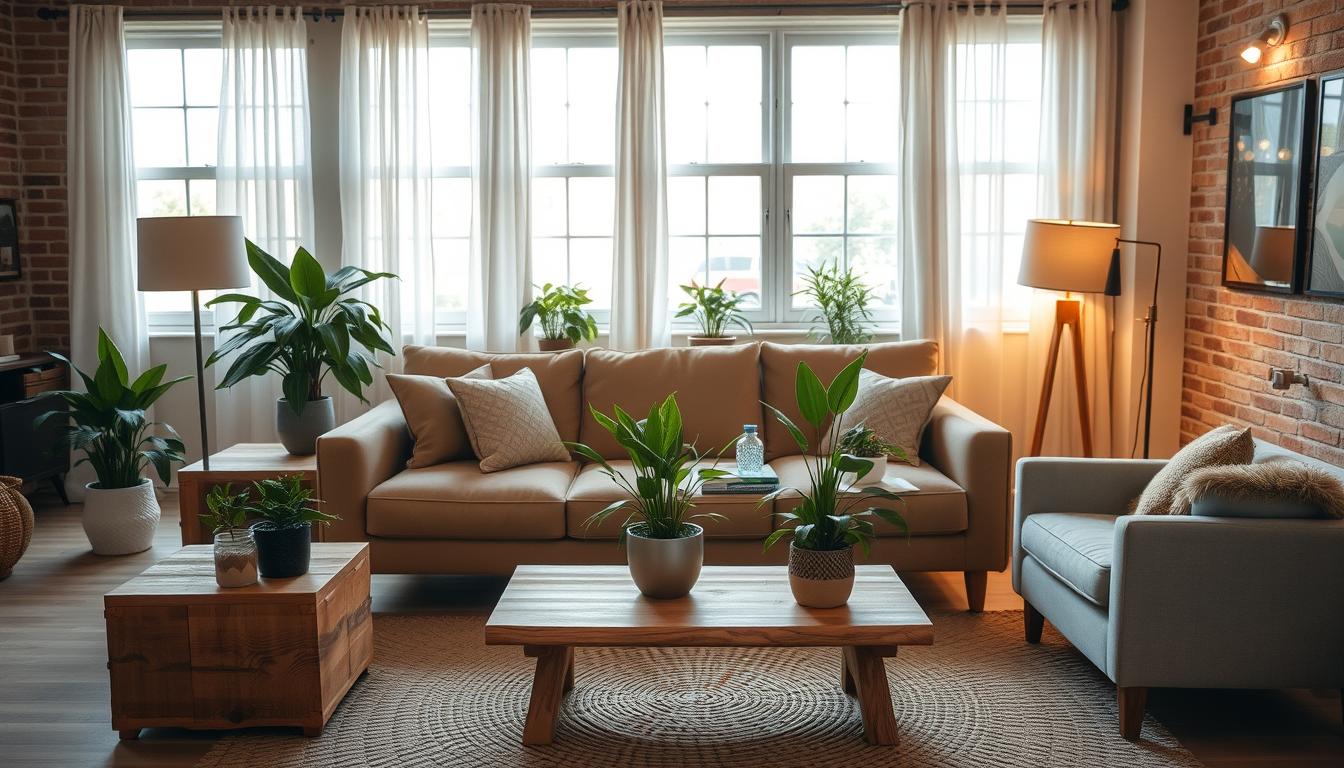In our fast world, adding leather to your organic workspace can change your space. It makes it look better and work better. This guide gives you tips for designing with nature and eco-friendly materials in mind, like leather. By mixing style with nature, your workspace can boost well-being and productivity. And it takes care of the environment too.
Understanding Organic Workspace Design
Organic workspace design blends nature into modern work areas, making spaces that boost creativity and productivity. It uses natural stuff like wood, stone, and bamboo. These materials look good and are eco-friendly, thinking about the planet’s health.
Such workspaces often have calm earth tones that make you feel relaxed. Adding plants makes the place more connected to nature and nicer to be in. They make the office look better and help us feel better, too.
Getting plenty of sunlight is crucial in organic design. Big windows or skylights let in sunshine, making the place feel positive and lively. This kind of light is good for our health and happiness at work. The main idea is to create offices that mimic nature’s beauty, which helps us feel more motivated and productive.

Importance of Eco-Friendly Materials
Using eco-friendly materials in office design is crucial for sustainability. Choices like reclaimed wood, bamboo, and sustainably sourced leather cut down on environmental harm. They also make the office look better. Choosing organic materials shows we care about the planet.
Eco-friendly materials make the air inside better, boosting productivity and health. These sustainable choices add unique beauty and let us customize our workspaces. By prioritizing sustainability, we create a welcoming space that reflects our eco-friendly beliefs.
Incorporating Leather Accents in Organic Workspace Design
Adding leather accents to an organic workspace design makes it look and work better. Choosing eco-friendly leather is key. Vegetable-tanned leather reduces chemicals and environmental harm. It’s a good choice for modern workspaces.
Choosing Sustainable Leather Options
When adding leather, it’s smart to pick sustainable options. Nowadays, lots of brands offer ethically made, durable leather. This means you can have stylish leather that’s also eco-friendly.
Combining Leather with Natural Materials
Mixing leather with materials like wood, stone, and fabric creates a rich look. This blend brings out a warm, elegant style. The mix of smooth leather and rough materials feels welcoming. It makes the office look nice and work well.
Create a Balanced Color Palette
A balanced color palette is key for a welcoming workspace. Colors like whites, beiges, and grays make a calm background. This lets natural materials and leather highlights stand out. Neutral colors boost an organic look and keep the mood peaceful, helping with work focus.
Add some excitement without too much clutter by using colorful accessories or art. These small touches of color will match the room’s look and keep to an organic style. This careful choice of colors makes the workspace look nice and feel motivating.
Maximizing Natural Light in Your Workspace
Natural light is crucial for a great workspace, affecting both mood and productivity. Think about the direction your windows face to let in light. Try to place desks near windows to enjoy the sunlight. This setup helps with seeing better and keeps you feeling creative.
If you don’t get much sunlight, look into other lighting options. Use full-spectrum LED bulbs to mimic natural light, making the space bright and welcoming. Put these lights around your workspace to keep every spot bright and boost energy.
Focus on natural light and use smart lighting to make a lively workspace. This approach improves well-being and matches natural design concepts.
Adding Texture with Leather and Other Elements
Texture is key in making a workspace look good. Adding different materials can make a place feel more welcoming and lively. Leather is a great starting point. It looks classic and goes well with many textures, adding depth and interest.
Textures that Complement Leather
To make your workspace feel even better, mix leather with materials like:
- Wool: Adds warmth and softness.
- Linen: Brings a light and airy feel.
- Wood: Introduces an organic element with natural grains.
These materials work well with leather. They create a balanced, beautiful look in any room.
Layering for Visual Interest
Adding layers is crucial for a space with depth. Use rugs, cushions, and art to make an area feel rich and welcoming. For example, a soft rug under a leather chair adds comfort and warmth. Adding different textures invites people to look closer and stay longer, moving away from plain styles.
Furniture Choices: Leather vs. Non-Leather Options
When picking furniture for a natural workspace, deciding between leather and non-leather is key. Leather furniture adds luxury and lasts a long time. It makes the workspace look elegant, offering a beauty and feel other materials can’t match.
Non-leather options also have great benefits, especially for comfort and being eco-friendly. They come from natural fibers, recycled stuff, or green composites. This matches organic design ideas and supports a greener planet, great for those wanting to lessen their environmental impact.
Think about these when choosing your furniture:
- Durability: Leather pieces tend to last longer, resisting everyday use and damage.
- Comfort: Non-leather offers more breathability and softness, making long sits more pleasant.
- Sustainability: Choose earth-friendly materials to keep your workspace design green. Non-leather often includes recycled components or eco innovations.
- Ergonomics: Opt for quality furniture that looks good and supports a comfy work area.
The best furniture choice balances leather’s luxury with the green positives of non-leather.
Integrating Greenery into Your Leather-Accented Workspace
Adding indoor plants to a workspace with leather accents can make it feel more natural. These plants clean the air and improve your mood. They also add beautiful colors that look great with leather. Choose plants that are easy to care for and don’t need much attention.
Place the plants strategically in your workspace for the best effect. Put them near leather furniture or on shelves with leather items. Doing this creates a connection with nature and makes your workspace look better.
Personalizing Your Workspace with Leather Accents
A personalized workspace shows your style and makes the space welcoming. Adding leather accents combines function and beauty in your workspace design. Leather decor pieces catch the eye, while leather accessories boost your work and organization.
Artistic Leather Decor Pieces
Add artistic leather pieces that match your taste. You might like handcrafted wall hangings or decorative sculptures. These items add depth to your space and give it personality.
Intricate leather artworks blend with natural elements, making your workspace warm and inviting. They help motivate and inspire you every day.
Functional Leather Accessories
Using functional leather items can make your workspace more efficient. Leather desk mats, organizers, and pen holders make your space neater and more stylish. They serve two purposes: they keep things organized and make your workspace look better.
When you mix these with your workspace, you get a balance of usefulness and style. This blend improves your workspace, making it truly your own.
Maintain a Minimalist Approach for Clarity
A minimalist design makes everything clear in a work area. By choosing a simple layout, we pay more attention to what’s important. This boosts work efficiency. Simple lines and shapes also make a place welcoming.
Deciding to declutter has big perks. When we get rid of extra stuff, the finer details like leather and natural designs pop. They look good and work well. A calm work area also sparks creativity and focus.
To keep things minimalist, try these tips:
- Choose only the most functional and beautiful items for your desk.
- Implement storage solutions to hide unnecessary clutter.
- Opt for neutral colors that promote calmness and focus.
- Limit personal items to a few meaningful pieces.
Leather Accents in Organic Workspace Design
Adding leather accents to an organic design makes a workspace both stylish and welcoming. It’s important to use sustainable leather to keep things eco-friendly. These accents blend well with natural colors, making the space look beautiful and balanced.
Using natural light makes everything look better, especially leather. Sunlight brings out the leather’s texture and beauty, improving the room’s mood. Adding plants makes the room feel alive and goes perfectly with the leather.
Think of leather as more than just a material in your workspace design. It should work together with eco-friendly practices, bright colors, and nature. This mix creates a space that’s not only good for work but also feels connected to the outdoors. It’s modern living at its best.
Conclusion
Adding leather accents to an organic workspace boosts its look and supports the environment. By following key organic workspace advice, you can blend beauty and practicality perfectly. This mix makes a space that sparks work efficiency. Also, pair leather with other earth-friendly materials to show you care about our planet.
Also, choosing the right colors and textures can make your workspace better. It’s important to add touches that match your taste, combining art and usefulness. This approach of mixing leather with eco-friendly options improves the feel of your workspace. It also helps you feel better while working.
To wrap up, leather accents in an organic workspace bring together style and green living. Follow these ideas to craft a workspace that fits your job and daily life better. This way, you get a place that’s not just good for working but also makes your everyday better.



